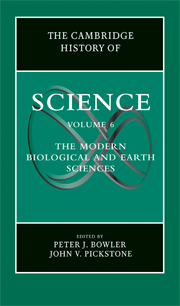Book contents
- Frontmatter
- 1 Introduction
- PART I WORKERS AND PLACES
- 2 Amateurs and Professionals
- 3 Discovery and Exploration
- 4 Museums
- 5 Field Stations and Surveys
- 6 Universities
- 7 Geological Industries
- 8 The Pharmaceutical Industries
- 9 Public and Environmental Health
- PART II ANALYSIS AND EXPERIMENTATION
- PART III NEW OBJECTS AND IDEAS
- PART IV SCIENCE AND CULTURE
- Index
- References
6 - Universities
from PART I - WORKERS AND PLACES
Published online by Cambridge University Press: 28 November 2009
- Frontmatter
- 1 Introduction
- PART I WORKERS AND PLACES
- 2 Amateurs and Professionals
- 3 Discovery and Exploration
- 4 Museums
- 5 Field Stations and Surveys
- 6 Universities
- 7 Geological Industries
- 8 The Pharmaceutical Industries
- 9 Public and Environmental Health
- PART II ANALYSIS AND EXPERIMENTATION
- PART III NEW OBJECTS AND IDEAS
- PART IV SCIENCE AND CULTURE
- Index
- References
Summary
Universities have been important to biology not merely by providing it with a home. Particular features of the university setting had a substantial impact on both the proliferation of new fields in the nineteenth century and the central questions that came to characterize those fields. The history of biological thought and practice must therefore make room for institutional history. Moreover, writing the history of “biology” poses particular problems. Unlike many subjects in the natural sciences (e.g., chemistry, physics) or the humanities (e.g., history, philosophy), “biology” has rarely been institutionalized as a single subject. Whenever the life sciences experienced growth within the universities, they displayed a remarkable tendency to be institutionalized separately rather than to remain together as an internally differentiated whole. Just why this has occurred is not clear, but its historiographical implication is that “biology” is best conceived as a collection of loosely connected areas of inquiry (I will call them “fields”) sharing little more than their concern with living organisms.
That said, the status that these fields have occupied within the university has varied considerably. Some of them (e.g., zoology or botany) were disciplines in the sense that they were central to the curriculum and were institutionalized in separate departments (or “institutes”) at most universities. But many fields were established for long periods of time without ever acquiring disciplinary status; for convenience, I will call them specialties (e.g., morphology, embryology, or cytology).
- Type
- Chapter
- Information
- The Cambridge History of Science , pp. 90 - 107Publisher: Cambridge University PressPrint publication year: 2009
References
- 18
- Cited by



